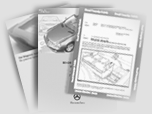 CAUTION! CAUTION!
Risk of Injury when performing Diagnostic Tests and repairs on components of the SRS system.
Store both airbags and side airbags with opening surface pointing upward.
Do not expose to temperatures above 100°C.
Interrupt any electrical current from reaching the airbag unit.
|
 CAUTION! CAUTION!
Risk of injury if airbag units and ETR units are ignited accidentally or if stored with the opening end facing downward which may cause the accidentally ignited components to fly about causing injury. Danger to persons also exists if the components are disposed of by cutting apart with cutting torches or other cutting/separation devices. Danger also exists if disposing the untriggered units via refuse collection or via smelting/carbonizing companies.
Protective measures/Supervision
- Place removed airbag unit with the opening side facing upward.
- Allow only properly trained dealer staff to supervise, purchase, transport, store, test/replace any of the SRS components.
- Install all airbag or ETR units once pulled from the parts department.
- Protect all airbag or ETR units from any sparks, open flame, or temperatures above 100°C.
- Do not transport airbag or ETR units in the passenger compartment, rather transport securely in their original packaging in the trunk.
- Do not allow oil, grease or cleaning agents come in contact with the airbag or ETR units
- Perform SRS tests only with approved test equipment (such as HHT), while installed in the vehicle without occupants.
- When reconnecting the vehicle battery or any outside electrical source, with the ignition turned ON, do not allow any occupants inside the vehicle.
- Airbag or ETR units which have been dropped from a height greater than 18 inches must be replaced.
- Prior to disposing the airbag or ETR units, the units must be made un-useable by discharging.
- In order to render the airbag and ETR unit un-useable, the specially made discharge harness must be used and at the same time maintain
a safe distance of at least 33 feet from the units being discharged.
Prior to undertaking any chassis/body repairs, installation/repair work on airbag and ETR units, or any components which come in contact with the airbag and ETR units, or are part of the electrical circuit of airbag and ETR units (such as installation of the steering wheel), the following conditions must be met:
- Remove ignition key.
- Disconnect any outside source of electrical circuit (i.e. battery charger).
- When performing interior repairs or welding operations, disconnect the connector from the SRS control module.
|
Preliminary work:
Diagnosis - Function Test  11 11 |
Test equipment; See MBNA Standard Service Equipment Program
| Hand-Held Tester (HHT) 1) |
See S.I. in groups 58 and 99. |
| 1) Available through the MBUSA Standard Equipment Program. |

A current fault is indicated by the DTC being highlighted in black.
Additional detailed information is given with most DTC's, which will indicate possible faults conditions or portions thereof:
>  Resistance too great. Resistance too great.
<  Resistance too low. Resistance too low.
  - Short circuit to ground (GND) - Short circuit to ground (GND)
  + Short circuit to positive (POS). + Short circuit to positive (POS).
-//- Open circuit.
Fault frequency and time span of the fault can be read by pressing the  key. key.
Fault frequency:
Faults are noted by frequency of occurrence, i.e.: 5 periodic faults, 5 occurances, eliminated 5 times.
Time span:
The amount of time elapsed since last fault, or since fault eliminated itself.
Actual values:
Four displays are possible:
 , ,  , ,   , ,    . .
 : Noted values are within the nominal values. : Noted values are within the nominal values.
 : Noted values are outside the nominal values. : Noted values are outside the nominal values.
  : Seat belt buckle latched : Seat belt buckle latched  , front passenger seat occupied. , front passenger seat occupied.
   : Seat belt buckle not latched : Seat belt buckle not latched  , front passenger seat not occupied. , front passenger seat not occupied.
Contrary to the DTC memory, actual values are updated continuously, even during diagnosis, so that, e.g.: by moving components, or connections and wiring harnesses, intermittent failures may be indicated, recognized.
Additional Actual Values:
If so equipped, with Seat Occupied Recognition (SOR) with Automatic Child Seat Recognition (ACSR) the additional information is shown:
Function:          
(SOR continues to be active regardless if MB Child seat "Babysafe" is not used or recognized).
Passenger seat:                    
Child seat:                    
Facing direction of child seat:                    

The actual values: SOR/ACSR are updated approx. every 15 seconds.
|
DTC
 |
Possible cause |
Hints |
Test step/Remedy 1) |
| No communication with HHT |
Diagnostic line |
|
 23 23 2.0 2.0 |
| No fault codes |
No fault codes recognized. |
In case of complaint;
Perform electrical Test  23 23 |
 23 23 |
     |
SRS control module (N2/2) |
|
N2/2 |
     |
Front passenger AB squib 1 (R12/4)
Faulty version coding |
|
 31 31 |
     |
Driver AB squib 1 (R12/3)
Faulty version coding |
|
 31 31 |
     |
Circuit 15R
Under or over voltage condition |
|
 23 23 1.0 1.0 |
     |
Driver ETR squib (R12/1)
Faulty version coding |
|
 31 31 |
     |
Left side airbag squib (R12/9)
Faulty version coding |
|
 31 31 |
     |
Front passenger ETR squib (R12/2)
Faulty version coding |
|
 31 31 |
     |
Right side airbag squib (R12/10)
Faulty version coding |
|
 31 31 |
     |
Left/right hand drive
Faulty version coding |
Model 163 as of 3/98, up to 12/99 |
 23 23 20.0 20.0 |
     |
Left front seat belt buckle/belt lock
switch (S68/7),   +, +,   -, -//- -, -//-
Faulty version coding |
|
 23 23 18.0, 18.0,
 31 31 |
     |
Right front seat belt buckle/belt lock
switch (S68/8),   +, +,   -, -//- -, -//-
Faulty version coding |
|
 23 23 19.0, 19.0,
 31 31 |
     |
SRS MIL (A1e15) |
|
 23 23 3.0 3.0 |
     |
Driver airbag squib (R12/3)
<  , > , >  |
|
 23 23 4.0 4.0 |
     |
Driver airbag squib (R12/3)
  +, +,   - - |
|
 23 23 5.0 5.0 |
     |
Front passenger AB squib (R12/4)
<  , > , >  |
|
 23 23 7.0 7.0 |
     |
Front passenger AB squib (R12/4)
  +, +,   - - |
|
 23 23 8.0 8.0 |
     |
Driver ETR squib (R12/1)
<  , > , >  |
|
 23 23 14.0 14.0 |
     |
Driver ETR squib (R12/1)
  +, +,   - - |
|
 23 23 15.0 15.0 |
     |
Front passenger ETR squib (R12/2)
<  , > , >  |
|
 23 23 16.0 16.0 |
     |
Front passenger ETR squib (R12/2)
  +, +,   - - |
|
 23 23 17.0 17.0 |
     |
Left side airbag squib (R12/9)
<  , > , >  |
|
 23 23 10.0 10.0 |
     |
Left side airbag squib (R12/9)
  +, +,   - - |
|
 23 23 11.0 11.0 |
     |
Right side airbag squib (R12/10)
<  , > , >  |
|
 23 23 12.0 12.0 |
     |
Right side airbag squib (R12/10)
  +, +,   - - |
|
 23 23 13.0 13.0 |
     |
Front passenger seat occupied recognition |
Only valid with ACSR
Model 163 as of 3/98, up to 12/99 |
 23 23 21.0 21.0 |
     |
Child seat:
Communication fault, -//-,   + +
Child seat:
  - - |
Only valid with ACSR
Model 163 as of 3/98, up to 12/99 |
 23 23 24.0 24.0 |
     |
Child seat:
Positioned incorrectly
Child seat:
Only one transponder recognized
Child seat:
"Signal" transmission fault between front passenger seat and "Babysafe" |
Only valid with ACSR
Model 163 as of 3/98, up to 12/99 |
 23 23 22.0 22.0 |
     |
AIRBAG OFF indicator lamp (A1e56)
-//-,   - - |
Only valid with ACSR
Model 163 as of 3/98, up to 12/99 |
 23 23 23.0 23.0 |
     |
Child seat not recognized, unknown
Child seat version code faulty
Child seat not approved |
Only valid with ACSR
|
Perform coding via HHT,
Use only approved Child seats,
 31 31 |
1) Observe Preparation for Test, see  22. 22. |
|


 Printable version
Printable version


 CAUTION!
CAUTION!  11
11

 Resistance too great.
Resistance too great. 
 - Short circuit to ground (GND)
- Short circuit to ground (GND)  ,
,  ,
, 
 ,
,  , front passenger seat occupied.
, front passenger seat occupied. 























 2.0
2.0









